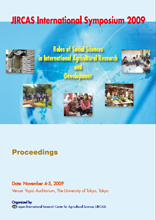Participatory Approach toward Agricultural and Rural Development

The societal change caused by modern development according to our historical experience
can be expressed by urban expansion indicated by the increasing rate of urban population in a
society. The final result of such transformation from a rural to urban industrial society is a big
decline in the agricultural sector. Japan is a case in point. The country’ agriculture is already a
small industry with a small number of labor force engaged in it.
As regards ‘participation’ in Development Studies, it became popular since the 1970s
mainly due to the failures of previous rural development projects. Earlier years mainly saw the
discussion centering on the definitional notion of participation. It was often pointed out that
participation stands for both ends and means of development, and that participation itself does
not necessarily show effective measures to its implementation. In more recent years efforts have
been made to invent various measures to promote popular participation in project
implementation in the rural areas of the developing countries. Though the importance of
participation in development projects is widely acknowledged, there still exist many cases of
donor-driven project implementation. Thus measures for real grassroots participation
instrumental in poverty alleviation in the Third World countryside are yet to be invented and
applied.
When we carefully look at the experience of agricultural and rural development in the
postwar Japan, it can be mentioned that there are important lessons to be learned for
participatory agricultural and rural development in today’s developing countries. The example
of these can be found in the Rural Livelihood Improvement Programs (R-LIP). They started in
the late 1940s as an integral part of the agrarian reform policy. Later the R-LIP itself has
become mature in terms of the idea and measure to put into practice.
In the R-LIP activities rural women were identified as their main target population. They
tried to help rural women help themselves with (1) problem identification through scientific
analysis of the real causes of the problems facing them, (2) thinking of possible ways to solve
them, (3) practical solution with using simple technology, and (4) executing evaluation and
reflection. Such problem-solving processes were cyclically practiced and the practical
problem-solving experiences were accumulated over a long period of time. The ideas and
methods of this R-LIP approach were not available at the very beginning of the R-LIP. They
were invented and formulated through practices of R-LIP activities by participant rural women
and female Livelihood Improvement Extension Workers involved in helping them.The agricultural sector has dramatically changed in the course of economic transformation
due to prevalent part-time farming and a general decline of agricultural popularity as occupation.
However, far as the R-LIP concerned, it has contributed both to productivity enhancement in
agriculture and uplift of rural livelihood because these two of farm households are two
wheels of a car. The more important is that practical problem-solving experiences have resulted
in women participants having become the active agents of rural life. This corresponds to the
emerging values in development, such as Gender and Development (GAD), the empowerment
of locals, particularly women, and human development. Therefore we can say that the R-LIP
experience in Japan is a typical example of participatory agricultural and rural development.
As long as people are alive, the needs of Livelihood Improvement exist regardless of time
and place. This is because the menu of Livelihood Improvement always differs according to the
levels of socio-economic conditions. The range of R-LIP activities has been changing from the
inception through the present LIP, including improved farming practices, rational farm
household lifestyles, family member health checks, keeping clean rural environments, farm
management skills, group farming for rice cultivation, business enterprising, and local economic
promotion. More recently, income generation and self-employment creation by farmwomen
have become common, with a result that there already exist many rural communities where
female participants play important roles in local food production and food processing either
individually or in groups.
Attention should be given to the fact that these achievements in R-LIP have not been
realized within a short period of time. Among the essential factors for successful R-LIP are
long-term commitments of women’s small group activities for Livelihood Improvement, the
accumulation of problem-solving experience, and social capital formation between female
participants and Livelihood Improvement Extension Workers. These factors have been
instrumental also in the promotion of income generating activities (IGA) by rural women with
making use of local technology and local resources.
R-LIP puts rural people at the center of development activities. The importance therefore
lies in its participatory ideas and approaches created through practical problem solving
experiences of R-LIP rather than in the actual project activities. Thus, it can be said that the
Livelihood Improvement approach offers significant and universal applicability to agricultural
and rural development elsewhere. There are already an increasing number of developing
countries in Asia, Africa and Latin America, in which the idea and method of R-LIP are already
introduced with the help of the training programs of Japan International Cooperation Agency
(JICA). What is interesting and important in these cases is the fact that the introduced
participatory approach toward agricultural and rural development are modified and/or
internalized so as to adapt to the local conditions in which development activities are in practice.
| 刊行年月日 | |
|---|---|
| 作成者 | Masami Mizuno |
| 著者キーワード |
rural development participatory approach R-LIP two wheels of production and life Japan’s |
| 公開者 | Japan International Research Center for Agricultural Sciences |
| オンライン掲載日 | |
| 号 | 2009 |
| 開始ページ | 72 |
| 終了ページ | 77 |
| 権利 | Japan International Research Center for Agricultural Sciences |
| 言語 | eng |
